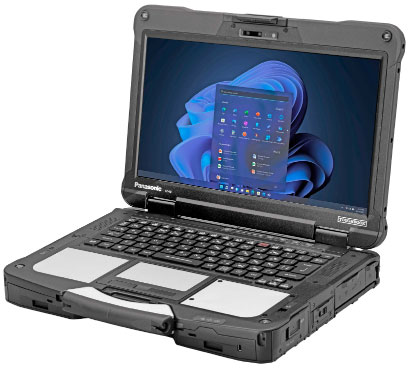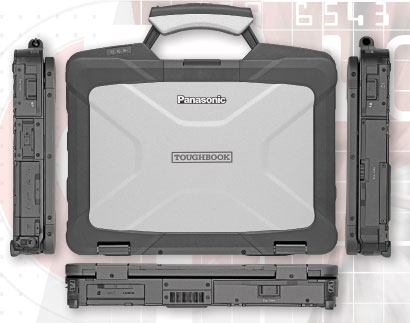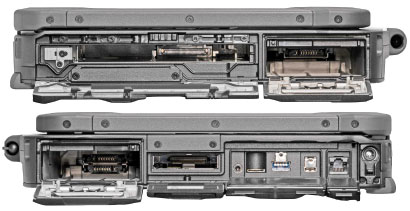|
Panasonic Toughbook 40
The original Toughbook is back, technologically up-to-date, lighter, faster, and infinitely customizable.
(by Conrad H. Blickenstorfer)
On May 24, 2022, Panasonic announced the Toughbook 40, a fully rugged modular laptop computer that seamlessly picks up where the old Toughbook 31, last updated in November 2018, left off. Those familiar with Toughbooks will recognize the shape and design of the new model right away; it's still much the same as the storied Toughbook of old, the one that started it all back in the '90s. But it's also brought up-to-date, and improved in many ways.

Why did Panasonic wait so long to update what was once its undisputed #1, the flagship of the line? That's hard to tell. Maybe Panasonic strongly believed in the future of "2-in-1" hybrids where the screen part is a tablet computer that can — but does not have to — work in conjunction with a detachable keyboard-with-benefits.
The company's Toughbook 20 and 33 went that way, and more recently the Toughbook 20-like Toughbook G2 as well. Those were nice enough machines, but perhaps their smaller screens (10 and 12 inches) and complexity of design left hardcore rugged laptop users wanting and wishing for a "real" Toughbook again.
If so, well, those customers got their wish now. The new Toughbook 40 is a real Toughbook, just like they used to be, only better and much more powerful.

It's not immediately obvious in the image above, but with the Toughbook 40, Panasonic finally switched from the tall and boxy 4:3 aspect ratio to the more modern 16:9, increasing screen diameter from 13.1 to 14 inches in the process. The old Toughbook 31's resistive touch screen has, of course, given way to capacitive, and resolution switched from the time-honored old XGA (1024 x 768 pixel) to more timely full HD (1920 x 1080).
In the boiler room, changes are substantial as well. Whereas the old Toughbook 31 was still stuck with comparatively ancient Intel 7th generation "Kaby Lake" chips, Panasonic took a giant leap for the Toughbook 40, all the way to 11th gen "Tiger Lake." That means pulling even with the current top-of-the-class, and even passing what is the Toughbook 40's most direct competitor, the Getac B360 PRO. Panasonic missed giving us the first Intel 12th Gen Alder Lake fully rugged, but the 11th gen Core i5-1145G7 and i7-1185G7 are excellent chips as is.
Something old, something new
As much as a good number of Toughbook fans will appreciate the new model, fact is that the rugged systems world has changed quite a bit since the early Toughbook days. Some of the latest fully rugged laptops weigh now half as much as the old Toughbook 31, and are less than half as thick.
That's because we're increasingly seeing a trend to offer fully ruggeds both in light, slender versions for when that matters, and also in beefier, heavier versions for when maximum battery life and lots of I/O are the order of the day. The Toughbook 40 doesn't have such a slender version (yet?); it is what it is, and that's 2.1 inches thick and have a starting weighing of 7.4 pounds. Granted, that's 0.8 thinner than the old Toughbook 31 and 1.2 pounds lighter despite the larger footprint, but part of that weight savings comes at the cost of a significantly smaller primary battery (70.2 vs 91.1 watt-hours).

The advantage of its hefty size is that there's plenty of room for I/O and all sorts of options. And this is where the new Toughbook 40 may differ most from its predecessor (we can't tell for sure until we may have hands-on, but that's what it seems for now): the Toughbook 40 heavily borrows from the modular design of the very successful semi-rugged Toughbook 55 where a broad variety of easily installable and changeable "xPAK" expansion packs make for almost unparalleled customization and personalization.
We're talking no fewer than eight modular user-replaceable locations on the new Toughbook 40, including four xPAK expansion areas. Add that to battery, memory, storage and keyboard options, and customers can not only configure their machines just right, but also protect their technology investments as their needs shift, and then modernize, expand, or update at their own pace.
While the Toughbook 40 is a bit late to the Intel 11th gen party, it can claim some interesting first. Two examples are the 5megapixel infrared webcam and the industry's first quad antenna pass-through connectors. And unlike some of the competition that solders RAM in place, Panasonic allows users to upgrade/change via two DIMM slots.
To get an idea what all has changed, check the table below:
|
Fully rugged TOUGHBOOK — new vs old
|
|
Model
|
Toughbook 40
|
Toughbook 31 Mk6
|
|
Introduced
|
2022
|
2018
|
|
OS
|
Windows 10 or 11
|
Windows 10
|
|
Processor
|
Core i7-1185G7 (up to 4.8GHz)
Core i5-1145G7 (up to 4.4GHz)
|
Core i7-7600U (up to 3.9GHz)
Core i5-7300U (up to 3.5GHz)
|
|
Cores/Threads
|
4/8
|
2/4
|
|
Graphics
|
Intel UHD or Iris
|
Intel HD Graphics 620
|
|
RAM
|
16-64GB DDR4-3200MHz
|
16 or 32GB DDR4-2133MHz
|
|
Storage
|
512GB-2TB nVME
|
256GB-512GB SATA
|
|
Slots
|
micro SDXC UHS-I
|
NA
|
|
SIM slots
|
1 x nanoSIM, 1 x eSIM
|
1 x nanoSIM
|
|
Expansion
|
4 x xPAK areas
|
Multimedia Bay (opt. drive or 2nd battery)
|
|
Display type
|
Direct bonded TFT LCD, 1200 nits, AR
|
Direct bonded TFT LCD, 1200 nits, AR
|
|
Display
|
14.0"/1920 x 1080 pixel (157 dpi)
|
13.1"/1024 x 768 pixel (91 dpi)
|
|
Digitizer
|
Capacitive pen/rain/glove
|
Resistive
|
|
Battery
|
70.2 watt-hour Li-Ion
|
91.1 watt-hour Li-Ion
|
|
2nd Battery
|
Opt. 70.2 watt-hour Li-Ion
|
Opt. media bay
|
|
Size (inches)
|
11.9 x 13.9 x 2.1
|
11.5 x 11.9 x 2.9
|
|
Weight (oz.)
|
7.4 lbs.
|
8.6
|
|
Sealing
|
IP66
|
IP65
|
|
Temp. range
|
unknown
|
unknown
|
|
Drops
|
6-feet 810H
|
6-feet 810G
|
|
Webcam
|
5mp with Windows Hello support
|
NA
|
|
C1D2
|
optional
|
optional
|
|
USB-A
|
2 x USB 3.0
|
1 x USB 2.0, 3 x USB 2.0
|
|
USB-C
|
1 x Thunderbolt 4
|
NA
|
|
Bluetooth
|
5.1 Class 1
|
v4.1 + EDR
|
|
WiFi
|
Wi-Fi 6 AX201
|
802.11a/b/g/n/ac
|
|
WWAN
|
Optional 4G LTE or 5G
|
Optional 4G LTE
|
As far as ruggedness goes, Panasonic pretty much wrote the book with its early rugged laptops, and the company continues to push the boundaries. It is easy to forget that not too long ago the predecessors of the Toughbook 40 only qualified as "semi-rugged." That changed a while ago, and it keeps changing. The Toughbook 40's ingress protection is at the IP66 level now, with the first "6" meaning the machine is totally protected against dust, and the second "6" that its protected against strong jets of water from all around.
Panasonic claims a stellar 6-foot drop spec, now measured in accordance with MIL-STD-810H procedures. That is extremely impressive. Reminds me of the Panasonic engineers' meticulous attention to every smallest detail I witnessed with my own eyes at the Panasonic factory in Kobe years ago.
First impression:
So where does that leave us with this new Toughbook 40? It's now technologically up-to-date, 11th gen Intel chips, Thunderbolt 4, 5G mobile broadband and all. It's more expandable than ever, taking a page from the Toughbook 55 modular xPAK playbook. It's big and heavy, though, and for now Panasonic doesn't have a lighter, handier fully rugged like Getac and Dell have. And pricing starts at US$4,899, up from US$3,699 when the predecessor Toughbook 31 was introduced 3-1/2 years ago.
Still, this is a Panasonic Toughtbook, which for many means it's the real deal. And it's also a "real" rugged laptop, and not a hybrid solution. All that carries weight. Overall it's definitely a good thing to have the Toughbook 40 as an option for all those tough jobs now. -- Conrad H. Blickenstorfer, May 2022
|
|
|
 Specifications Panasonic Toughbook 40 Specifications Panasonic Toughbook 40
|
|
Status
|
Added: 05/2022
|
|
Processor
|
Intel Core i5-1145G7
Intel Core i7-1185G7 |
|
CPU Speed
|
i5-1145G7: up to 4.4GHz with Turbo Boost, 8MB cache
i7-1185G7: up to 4.8GHz with Turbo Boost, 12MB cache
|
|
Graphics
|
Intel UHD Graphics (with 1 DIMM) — Intel Iris Xe Graphics (with 2 DIMM); optional AMD dedicated graphics
|
|
Standard/Max RAM
|
User-upgradeable RAM (up to 2 DIMMs) 16-64GB total DDR4-3200MHz
|
|
Disk/drive
|
512GB to 2TB quick-release OPAL encrypted NVMe SSD with heater; optional 2nd 512GB or 1TB quick-release OPAL SATA SSD with heater
|
|
Optical drive
|
Optional Blu-Ray or DVD xPAKs
|
|
Card slots
|
1 x MicroSDXC UHS-I Card, 1 x nano-SIM, 1 x eSIM
|
|
Display type
|
Daylight-readable transmissive TFT (1-1200 Nit) with LED backlight and AR treatment
|
|
Display size/res
|
14.0-inch FHD (1920 x 1080 pixel), 157ppi
|
|
Digitizer/pens
|
Procap
|
|
Keyboard/scale
|
Integrated backlit 82-key, 100%-scale, 8 programmable keys, color-selectable backlit with 4 adjustable levels (emissive or rubber)
|
|
Housing
|
Magnesium alloy
|
|
Operating Temp
|
MIL-STD-810G, Method 501.5, Procedure II -140°F Operating; MIL-STD-810G, Method 502.5, Procedure II -- -20°F Operating
|
|
Sealing
|
IP66
|
|
Sand and dust
|
MIL-STD-810G, Method 510.5, Procedure I
|
|
Humidity
|
MIL-STD-810G, Method 507.5, Procedure II (Aggravated) -- Temp. cycles 86F to 140F; 95% RH
|
|
Explosive atmosphere
|
Optional hazardous location Class I Division 2, Groups ABCD certified model
|
|
EMI
|
MIL-STD-461F certified
|
|
Shock
|
MIL-STD-810H, Method 516.6, Procedure IV -- 26 drops - 72in height on to 2in plywood - non operating
|
|
Vibration
|
operating: MIL-STD-810G, Method 514.6, Procedure I; non-operating: MIL-STD-810G, Method 514.6, Procedure I (Transportation)
|
|
Size (WxHxD)
|
11.9 x 13.9 x 2.1 inches
|
|
Weight
|
Starting at 7.4 pounds (3.35 kg)
|
|
Power
|
Standard 10.8V/6,500mAH/70.2whr Li-Ion ("18 hours"), 36 hours with optional 2nd 70.2whr battery
|
|
Interface
|
2 x USB 3.0 Type-A, 1 x Thunderbolt 4 Type-C, HDMI, headphones/speaker, microphone/line in, 1 x RS232 DB9, ext. antenna connector, 1 x RJ45 gigabit LAN; optional: VGA, RS232, 2nd RJ45, second HDMI
|
|
Wireless
|
Intel Wi-Fi 6 AX201, Bluetooth v5.1 Class I, optional dedicated GPS (u-blox NEO-M8J), optional 4G EM7690, optional 5G EM9190 |
|
List price
|
US$4,899 (street price base model)
|
Website
|
Panasonic
|
Product page
|
Toughbook 40
|
Spec sheet
|
 Toughbook 40 Toughbook 40
|
|
|

|
|



